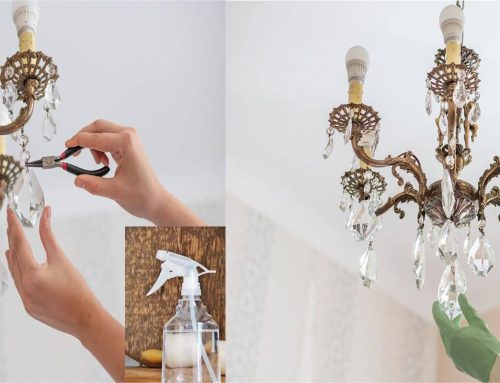Changing your home’s light display is one of the easiest and most affordable DIY decorating updates. Hanging chandeliers are a lighting option that can add style and visual appeal to your living space. Chandeliers come in many different styles and sizes. Traditional ornate crystal chandeliers are the centerpiece of many homes, but modern chandeliers made of metal and glass are designed for smaller living spaces. This chandelier installation guide shows you how to install a chandelier step by step, from calculating the hanging distance of the chandelier from the ceiling to choosing the bulb to use.
1. Remove the old device
Here are five steps to explain in detail:
1) Turn off the power
The first step in installing a chandelier is to turn off the power. Using electricity means taking extra precautions. You will be using wiring that is connected to a power source in your home, which can be dangerous.
Before starting a DIY project, you need to disconnect the power to the room. Turn off the power to the circuit where the chandelier is located, or unscrew the fuse of the lamp to be replaced. If the circuits are unmarked, you may have to test them through trial and error until the current light fixture is turned off.
Find the switchboard in your home. If you don’t know where the switchboard is, see How to Find a Fuse Box or Circuit Breaker Box. Switch the main circuit breaker in the room you want to work into the “Off” position to turn off the power to that room. Location.
As a precaution, turn off and then on light switches in the room to make sure the power is turned off.
2) Make sure the power is off
Turn the light switch on and off several times to ensure that the current light fixture is not powered on. If no fixtures are currently installed at this location, test each wire using a non-contact voltage tester or circuit tester. You can use a multimeter instead, although this device is more complicated to use.
Follow the instructions carefully when using a multimeter to test the voltage. Using the wrong settings can result in incorrect readings or damage to the device.
3) Remove the removable part from the old fixture
If the currently installed light fixture includes a bulb, glass shade, or other removable part, remove it immediately and set it aside. This makes it easier to remove the fixtures without damaging these parts.
If the light fixture is small and you have an assistant to help you remove it, you can skip this step.
4) Remove the old fixtures.
You may need a screwdriver or wrench to remove any screws or locking nuts holding the light fixture to the ceiling. Before removing the light fixture from the ceiling, make sure that you or your assistant hold the light fixture firmly. Do not remove the wires yet.
This step may be much easier if you have an assistant holding the fixture. We might need a stepladder. Do not allow old light fixtures to hang without any support other than wiring. This can cause the luminaire to fall and damage the wiring.
5) Pay attention to the way the wires are connected.
There should be two or more wires connecting the old light fixture to the home electrical system. They can be color-coded with white and black insulators, or identified with ridges or letters. While these instructions will provide full wiring instructions later, you may have an easier time if you draw a diagram of where each wire connects. If the wires are not easily distinguishable, mark them with colored tape.
(Another related post: How to Choose the Right Bulb for Chandeliers?)
2. Install brackets for your chandelier
Here’s a detailed look at six steps:
1) Prepare the ceiling box
Ceiling boxes, often called electrical boxes, can hold the room’s light fixtures or ceiling fans as well as any connected wiring. It is firmly fixed to joists or wooden blocks. Most ceiling boxes can hold 50 to 75 pounds, so make sure the ceiling box is rated to be heavy enough to support your chandelier installation.
Remove existing light fixtures or ceiling fans. Tighten the screws to ensure that the ceiling box is securely attached to the ceiling.
Disconnect the light fixture and set it aside.
2) Verify that your new chandelier can be safely hung from the mounting box.
Check the rating of the original chandelier mounting box. Then, check if the mounting box can support your other chandeliers.
If the current support is enough to support your chandelier, you can skip to the next section. For reference, a typical ceiling mounting box has a support weight of no more than 50 pounds (22.7 kg).
3) Remove the existing mounting box
The plastic or metal box should be secured to the ceiling or support rods using screws or nails. Remove it with a screwdriver or hammer, then pry the box away from the ceiling. These are also called junction boxes or electrical boxes.
4) Saw the existing support rods
If there is a metal bar in the ceiling, use a close-range hacksaw to cut it in half. Pull the two pieces through the hole and discard.
5) If fixtures are located between ceiling joists, use fan brackets
Buy a fan bracket that can support a higher weight than a chandelier; Most can support up to 150 pounds (68 kg). Place the fan bracket through the hole in the ceiling and rotate it so that it is placed across the hole at the top of the ceiling. Stretch the arm by turning the bar with your fingers until you feel both ends touching the ceiling joist.
Use a wrench to tighten the support, but do not apply excessive force to the joist. The spiky ends should be inserted into the wooden joists, and the sides of the rectangular rods should be parallel to the ceiling.
Place the bracket that came with the fan bracket on top of the bracket and thread the bolt through its hole. Insert the mounting box into the bolt and tighten the nut to connect.
6) If the light fixture is located under the ceiling joist, use a pancake box
Heavy-duty junction boxes are round metal objects, sometimes called “pancake boxes.” Make sure to choose a chandelier that can support the weight of the chandelier. Mount it to the ceiling joists using only the high load-bearing screws that came with the box. Do not attempt to use standard screws, or the chandelier may fall from the ceiling.
Before connecting, make sure to thread the wire through the hole on the side of the box. Once the boxes are installed, they should be easy to reach.
(Another related post: How to Clean a Chandelier?)
3. Install chandeliers
Here are 11 steps to explain in detail:
1) Assemble the chandelier base
Screw all the parts of the chandelier together, except for the canopy that will be attached to the ceiling. Do not install a light bulb yet, as it is easier and safer to install a chandelier without one.
2) Shorten the chain if necessary
Your chandelier may have more chains than you need. Determine how long you want the chain to be, then use a pair of heavy pliers to open one of the links of the chain at the selected point and remove the excess length.
When hanging a chandelier, two factors determine the length of the chain: the height of the room and the distance from the dining table to the bottom of the chandelier. This requires some calculation to ensure that the bottom of the chandelier is not too far from the ceiling.
Use a tape measure to determine the height from ceiling to floor and from ceiling to table. Chandelier chains should be 3 inches long for every foot of ceiling height. For example, a light fixture should hang from an 8-foot ceiling, 30 inches to 36 inches above the table, depending on the size of the chandelier.
Make sure your chain size includes a 4-inch pendant ring plus a chain link.
3) Install the mounting bar on the mounting box
This small metal bar with holes should come with your chandelier, or one may already be installed. They are also available at hardware stores.
To install the mounting bar, simply screw it into the existing screw holes in the junction box, the positions of which vary depending on the junction box design. Be sure to use the right size screws for a tight connection.
4) Run the chandelier wire through each part of the chandelier
Thread all wires from the chandelier through all other links. Continue pushing them through the metal cover, which will cover the electrical box, the small chain bracket attached to the top of the chain, and finally the thin metal joint that holds the wires together. They should extend completely across the nipple, far enough so that you can easily use them.
5) Install the chandelier
There are two common ways to hang a chandelier from the ceiling. Please refer to the manufacturer’s manual for instructions on installing a specific chandelier.
Here are some hints:
- Screw the chandelier mounting bracket to the ceiling box to install the chandelier mounting bracket. Pick up the hook at the end of the chandelier and insert it into the stand.
- Screw the mounting rod of the light fixture into the existing mounting bracket on the ceiling box.
- In order to connect each wire, you need to secure the chandelier stably near the ceiling. Either have a powerful assistant hold the chandelier in place or hang a chain or chain bracket from a strong hook hanging from the mounting bar.
(Another related post: Types of Chandelier: What’s the Best Option for You?)
6) Wrap each bare copper wire around the ground screw
Chandeliers and home electrical systems should have bare copper ground wires. Each wire should be wrapped around the ground screw on the junction box to ensure that the two wires touch each other. The screw is usually green.
In the event of a fault, the ground wire sends excess current to the ground (or other safe location).
7) Peel the skin off the end of the chandelier insulation wire
Use wire strippers to remove about 0.5 inches (1.25 cm) of insulation from each wire to expose exposed wires.
8) Connect the neutral lines together
In normal use, the neutral wire transmits the current to the ground. Find chandelier threads with identifying marks, such as grooves, ridges, or letters. Place the exposed end of the wire with the end of the white insulated wire running through the junction box and twist it with the wire connector.
You can choose to splice the wires yourself and cover the joints thoroughly with electrical tape.
If the ceiling wires do not have white insulation, you may want to refer to the drawing of the old light fixture made in the previous section and determine which wire of the old light fixture is a neutral wire (with the identification mark as described above).
9) Connect hotlines together
These are the wires that carry the electricity to the chandelier. The black insulated ceiling wire shall be connected in the same manner as the insulated chandelier wire without an identification mark. Twist the bare end with the plastic wire connector.
If there are more wires than mentioned here, or if the number of wires in the chandelier and junction box does not match, you may need to call an electrician to install the system safely.
10) Secure the chandelier in place
After installing and wiring the chandelier, tighten the bolts or locking nuts to secure it to the ceiling. This process may vary depending on your chandelier model, so you may need to read the instructions to find the connection point.
11) Test the chandelier
Install the bulb, turn on the power, and test the chandelier. If it doesn’t light up, you may be connected to the wrong wire. Be sure to turn off the power before attempting to switch the wiring. If you can’t get the chandelier to work yourself, call an electrician.
(Another related post: Chandelier 101: All You Need to Know)
4. Installation of chandelier FAQ
Here are three more common problems when installing chandeliers:
1) Do you need an electrician to install the chandelier?
The project requires the use of electricity, which can be dangerous. Whether you’re just replacing fixtures or powering an entire new location, a licensed electrician can install new lighting for you. Professionals know how to install lamps correctly and quickly according to local codes.
2) How much does it cost to have an electrician install the chandelier?
A manually installed chandelier that replaces only an existing fixture costs $100 to $350, and a new fixture costs $200 to $2,000. Chandeliers cost an average of $120 to $1,400, depending on size and type. Electricians pay more to hang chandeliers from high ceilings or stairwells.
3) Can I hang the chandelier by myself?
Installing a chandelier does not necessarily require specialized knowledge. If you hang it in an easy-to-reach location and know how to use a screwdriver and wire, you can install one. The chandeliers hang in the same way.
4) Is it illegal to hang a chandelier over a bathtub?
Can I install a hanging light above the bathtub in the bathroom? The National Electrical Code prohibits the installation of a suspended ceiling light fixture within 3 feet of the horizontal direction of the bathtub unless the clearance from the bottom of the light fixture to the top of the bathtub is 8 feet or more.
5) How hard is it to rewire a chandelier?
Rewiring chandeliers is very simple. The next time you see a KILLER pendant at a garage sale but are worried it won’t work… Just buy it. Basic electricity is very cheap and the process is fairly simple.
(Another related post: A Quick Guide for Chandelier Load Testing)
5. Conclusion
Above we introduce you in detail how to install the chandelier, if you have any doubts or suggestions in the article, welcome to contact Postmodernlighting.






Leave A Comment